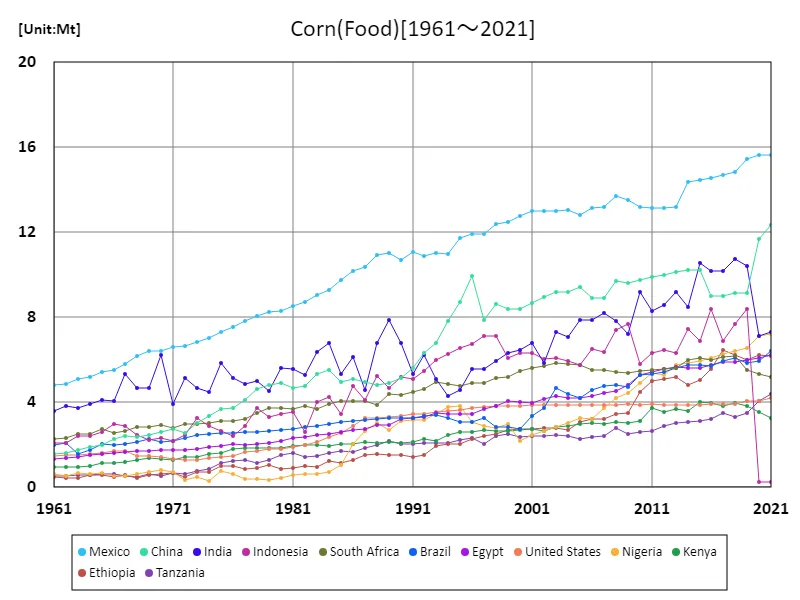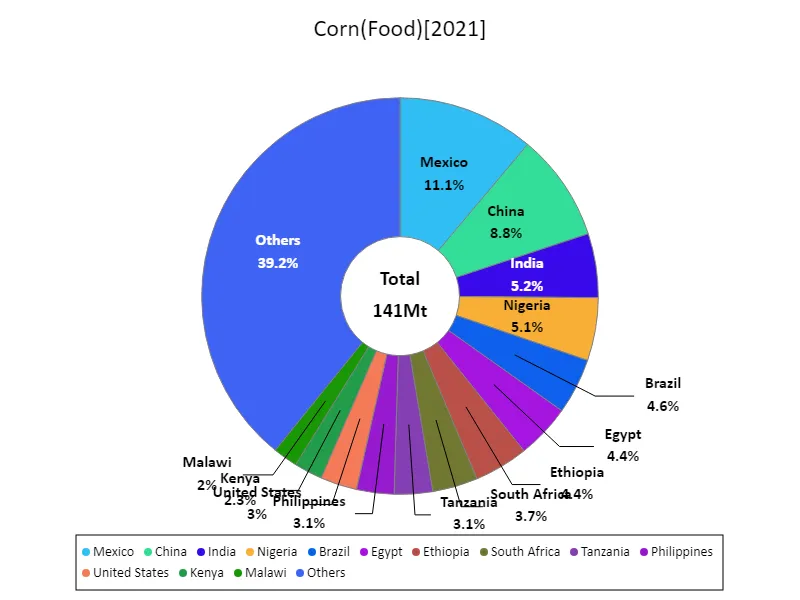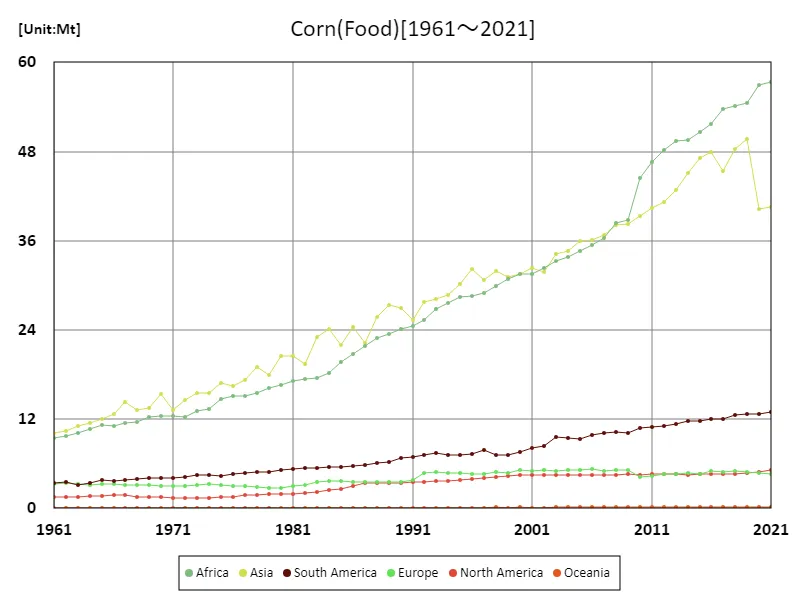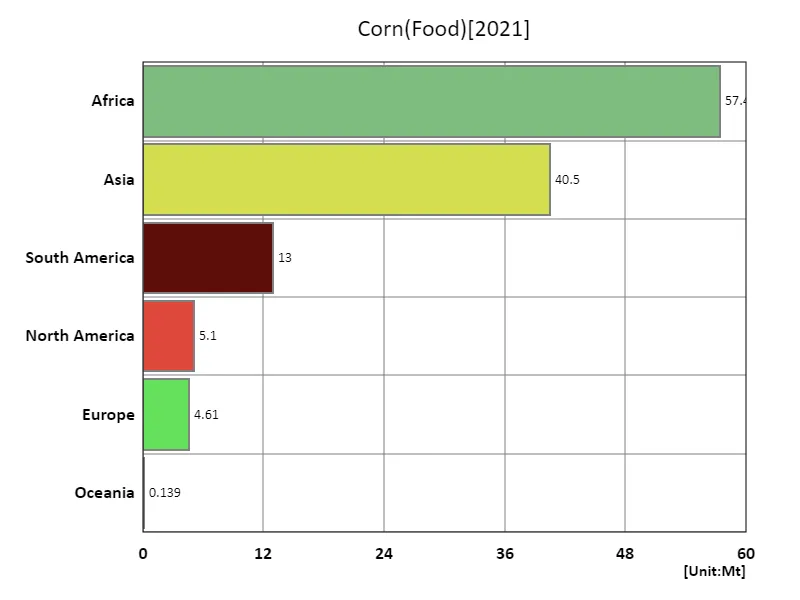Abstract
Global corn production has seen significant shifts over the years, with China being a dominant player. As of 2022, China recorded the highest amount at 1.43g, reflecting its large-scale farming and consumption. Historically, the U.S. has been the leading producer of corn, with vast areas dedicated to its cultivation, primarily for animal feed and biofuel. Over time, the rise of countries like Brazil and Argentina has diversified global production. Corn, a versatile crop, is vital for food, livestock feed, and industrial uses, with increased focus on enhancing yield through biotechnology and sustainability practices.
Corn as food (worldwide)
Global corn production has evolved significantly from 1961 to 2022, with China emerging as a leading producer. The peak production occurred in 2021, with China reaching 1.46g, currently at 97.8% of this peak. Historically, the U.S. has been the top producer, but China’s rapid agricultural advancements have increased its share, driven by large-scale farming and technological innovations. Over time, there has been a rise in corn production in other countries like Brazil and Argentina. Corn remains vital for food, livestock feed, and biofuel, with growing emphasis on sustainability and artificial corn technologies to boost yields.


The maximum is the latest one, 15.6Mt of Mexico
Corn as food (latest year, countries around the world)
In 2022, the global corn market saw China as the largest producer, with a total of 7.82g, and an average of 46m, with its peak production at 1.43g. Historically, China has steadily increased its share in global corn production, driven by both domestic demand and advances in agricultural technology. The U.S. remains a key player in global corn markets, but China’s growing production highlights the importance of corn for food security, livestock feed, and industrial uses like biofuels. Trends show increasing diversification in production, with emerging markets like Brazil and Argentina expanding their roles in the global corn economy.


The maximum is 15.6Mt of Mexico, the average is 781kt, and the total is 141Mt
Corn Food (Continent)
Artificial corn, a term referring to genetically modified or enhanced corn, has seen significant growth since 1961. The highest value recorded was 4.72g in Asia, marking a key milestone in its development. Over time, artificial corn has become a critical component in global agriculture due to its ability to increase yield, resist pests, and withstand environmental stress. Asia, particularly countries like China and India, have adopted biotechnology to address food security challenges. As global demand rises, artificial corn’s role in enhancing agricultural productivity and sustainability continues to expand.


The maximum is the latest one, 57.4Mt of Africa
Corn as food (latest year, continental)
In 2022, artificial corn production reached a peak of 4.72g in Asia, with an average of 1.47g and a total of 7.37g globally. Asia has been a key region in adopting genetically modified corn, driven by the need to increase yield and improve resistance to pests and environmental challenges. The rise of biotechnology in agriculture has allowed countries like China and India to enhance their corn production, contributing to food security. With growing global demand for corn in food, livestock feed, and biofuels, the trend toward artificial corn is expected to continue, fostering sustainability and higher productivity.


The maximum is 57.4Mt of Africa, the average is 20.1Mt, and the total is 121Mt
Main data
| Production(Corn, Food) [Mt] | ||||||||||
|---|---|---|---|---|---|---|---|---|---|---|
| World | Africa | Lower-middle-income countries | Upper-middle-income countries | Net Food Importing Developing Countries | Asia | Americas | Low Income Food Deficit Countries | Least Developed Countries | Eastern Africa | |
| 2021 | 140.67 | 57.41 | 54.07 | 51.35 | 50.26 | 40.55 | 37.96 | 36.41 | 31.72 | 25.04 |
| 2020 | 139.34 | 56.94 | 54.19 | 50.4 | 50.47 | 40.26 | 37.23 | 35.62 | 30.52 | 24.93 |
| 2019 | 146.23 | 54.47 | 57.02 | 55.72 | 50.47 | 49.71 | 37.06 | 33.98 | 29.04 | 23.86 |
| 2018 | 143.76 | 54.06 | 55.77 | 55.13 | 48.91 | 48.3 | 36.17 | 33.1 | 28.38 | 23.49 |
| 2017 | 139.68 | 53.72 | 53.49 | 53.6 | 48.59 | 45.4 | 35.52 | 32.97 | 28.43 | 23.35 |
| 2016 | 139.93 | 51.75 | 54.04 | 54.38 | 46.93 | 47.95 | 35.1 | 31.61 | 26.97 | 22.31 |
| 2015 | 137.19 | 50.65 | 52.48 | 54.04 | 45.49 | 47.13 | 34.68 | 30.82 | 26.11 | 21.72 |
| 2014 | 133.92 | 49.54 | 48.96 | 54.51 | 44.12 | 45.11 | 34.35 | 29.95 | 25.68 | 21.08 |
| 2013 | 129.77 | 49.39 | 47.9 | 51.28 | 44.04 | 42.77 | 32.81 | 30.31 | 25.68 | 21.73 |
| 2012 | 126.56 | 48.21 | 45.26 | 50.42 | 42.86 | 41.27 | 32.39 | 30.36 | 25.46 | 21.6 |
| 2011 | 123.6 | 46.55 | 44.24 | 49.66 | 41.42 | 40.36 | 32.18 | 29.06 | 24.07 | 20.73 |
| 2010 | 120.24 | 44.49 | 43.08 | 48.87 | 39.37 | 39.37 | 32.01 | 27.49 | 22.95 | 19.37 |
| 2009 | 113.76 | 38.82 | 39.83 | 50.36 | 34.29 | 38.22 | 31.48 | 38.07 | 19 | 16.81 |
| 2008 | 113.35 | 38.37 | 39.54 | 50.51 | 34.13 | 38.05 | 31.7 | 38.43 | 18.8 | 16.86 |
| 2007 | 109.53 | 36.43 | 38.43 | 48.38 | 32.38 | 36.78 | 31.16 | 36.63 | 17.43 | 15.6 |
| 2006 | 107.46 | 35.36 | 36.97 | 47.76 | 31.32 | 36.1 | 30.62 | 35.31 | 16.98 | 15.56 |
| 2005 | 105.79 | 34.68 | 36.13 | 47.27 | 30.75 | 35.98 | 29.84 | 34.65 | 16.42 | 15.13 |
| 2004 | 103.84 | 33.8 | 34.48 | 47.61 | 29.9 | 34.57 | 30.16 | 32.88 | 15.93 | 14.67 |
| 2003 | 102.79 | 33.33 | 33.54 | 47.83 | 28.84 | 34.18 | 30.17 | 31.87 | 15.65 | 14.73 |
| 2002 | 98.21 | 32.31 | 31.03 | 45.7 | 27.88 | 31.79 | 28.82 | 29.27 | 15.22 | 14.34 |
| 2001 | 97.43 | 31.54 | 31.31 | 45.31 | 27.03 | 32.39 | 28.4 | 29.72 | 14.73 | 14.23 |
| 2000 | 95.68 | 31.49 | 30.67 | 43.71 | 27.11 | 31.53 | 27.41 | 29.11 | 14.7 | 14.14 |
| 1999 | 93.53 | 30.86 | 30.64 | 42.66 | 26 | 31.08 | 26.72 | 29.23 | 14.14 | 14.01 |
| 1998 | 93.08 | 29.93 | 29.59 | 43.59 | 25.6 | 31.87 | 26.35 | 28.26 | 13.78 | 13.49 |
| 1997 | 90.95 | 29.01 | 28.43 | 42.69 | 24.94 | 30.72 | 26.5 | 27.33 | 13.17 | 13.05 |
| 1996 | 91.49 | 28.57 | 28.18 | 44.26 | 24.09 | 32.2 | 26.01 | 27.28 | 12.92 | 13.11 |
| 1995 | 88.96 | 28.42 | 28.08 | 42.21 | 23.6 | 30.23 | 25.5 | 26.66 | 12.48 | 12.52 |
| 1994 | 85.86 | 27.62 | 27.19 | 40.17 | 22.55 | 28.74 | 24.63 | 25.71 | 11.9 | 11.94 |
| 1993 | 84.7 | 26.76 | 26.98 | 39.46 | 21.77 | 28.18 | 24.77 | 25.64 | 11.53 | 11.42 |
| 1992 | 82.02 | 25.27 | 27.47 | 37.57 | 20.9 | 27.78 | 24.16 | 25.44 | 10.78 | 10.93 |
| 1991 | 77.96 | 24.52 | 25.31 | 35.88 | 20.35 | 25.32 | 24.21 | 23.89 | 10.52 | 10.47 |
| 1990 | 78.06 | 24.08 | 26.5 | 35.27 | 20.06 | 26.9 | 23.45 | 24.98 | 10.48 | 10.45 |
| 1989 | 77.72 | 23.48 | 26.88 | 34.45 | 19.7 | 27.37 | 23.28 | 25.69 | 10.53 | 10.7 |
| 1988 | 75.21 | 22.85 | 25.77 | 33.93 | 19.14 | 25.75 | 23.01 | 24.38 | 10.21 | 10.44 |
| 1987 | 69.89 | 21.79 | 22.55 | 32.16 | 18.05 | 22.27 | 22.19 | 21.06 | 9.43 | 9.78 |
| 1986 | 70.16 | 20.78 | 23.2 | 32.68 | 17.51 | 24.43 | 21.34 | 21.51 | 9.19 | 9.33 |
| 1985 | 65.54 | 19.63 | 21.1 | 30.37 | 17.17 | 21.98 | 20.25 | 19.71 | 9.22 | 9.34 |
| 1984 | 65.48 | 18.27 | 21.44 | 31.07 | 16.44 | 24.07 | 19.45 | 20 | 8.58 | 8.93 |
| 1983 | 63 | 17.48 | 20.78 | 29.98 | 15.82 | 23 | 18.96 | 18.82 | 8.05 | 8.39 |
| 1982 | 58.45 | 17.37 | 19.39 | 27.67 | 15.5 | 19.43 | 18.4 | 17.57 | 7.9 | 8.34 |
| 1981 | 58.46 | 17.06 | 19.58 | 27.93 | 15.35 | 20.5 | 17.89 | 17.66 | 7.98 | 8.26 |
| 1980 | 57.17 | 16.55 | 18.98 | 27.7 | 14.86 | 20.43 | 17.38 | 17.39 | 7.81 | 8.05 |
| 1979 | 53.92 | 16.24 | 16.83 | 26.8 | 14.21 | 18 | 16.92 | 15.88 | 7.63 | 8.05 |
| 1978 | 54.12 | 15.55 | 17.32 | 26.67 | 13.7 | 19.03 | 16.56 | 16 | 7.26 | 7.6 |
| 1977 | 51.54 | 15.13 | 17.17 | 24.59 | 13.58 | 17.27 | 16.12 | 15.6 | 7.18 | 7.6 |
| 1976 | 50.15 | 15.13 | 17.36 | 23.31 | 13.54 | 16.48 | 15.53 | 16.06 | 7.24 | 7.39 |
| 1975 | 49.81 | 14.7 | 17.68 | 22.99 | 12.95 | 16.85 | 15.04 | 16.39 | 6.89 | 6.85 |
| 1974 | 46.9 | 13.41 | 15.28 | 22.61 | 12.33 | 15.51 | 14.68 | 13.97 | 6.4 | 6.22 |
| 1973 | 46.16 | 13.07 | 15.19 | 22.35 | 11.77 | 15.58 | 14.36 | 14.07 | 6.1 | 5.97 |
| 1972 | 43.85 | 12.35 | 15.17 | 20.62 | 11.05 | 14.59 | 13.87 | 13.95 | 5.53 | 5.34 |
| 1971 | 42.37 | 12.4 | 13.96 | 20.27 | 10.89 | 13.17 | 13.72 | 12.94 | 5.56 | 5.29 |
| 1970 | 44.31 | 12.35 | 16.16 | 20.13 | 10.68 | 15.34 | 13.54 | 15.14 | 5.31 | 5.12 |
| 1969 | 42.75 | 12.31 | 14.65 | 19.86 | 10.93 | 13.55 | 13.69 | 13.73 | 5.56 | 5.28 |
| 1968 | 41.27 | 11.63 | 13.99 | 19.57 | 10.23 | 13.25 | 13.23 | 13.01 | 5.11 | 4.83 |
| 1967 | 41.88 | 11.43 | 14.53 | 19.34 | 10.37 | 14.34 | 12.91 | 13.74 | 5.33 | 4.95 |
| 1966 | 39.41 | 11.03 | 12.95 | 18.76 | 9.97 | 12.62 | 12.43 | 12.11 | 5.15 | 4.7 |
| 1965 | 38.67 | 11.21 | 12.89 | 18.33 | 9.83 | 11.97 | 12.23 | 12.29 | 5.25 | 4.75 |
| 1964 | 36.73 | 10.64 | 12.4 | 17.26 | 9.53 | 11.45 | 11.54 | 11.75 | 5.13 | 4.47 |
| 1963 | 35.54 | 10.15 | 12.03 | 16.68 | 8.99 | 11.07 | 11.05 | 11.23 | 4.86 | 4.16 |
| 1962 | 34.88 | 9.78 | 11.88 | 16.24 | 8.74 | 10.42 | 11.24 | 10.99 | 4.73 | 4.06 |
| 1961 | 33.86 | 9.52 | 11.4 | 15.75 | 8.42 | 10.07 | 11.01 | 10.77 | 4.65 | 4.03 |



Comments